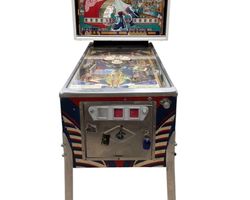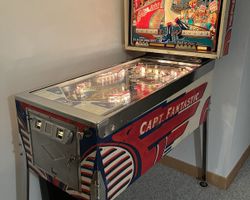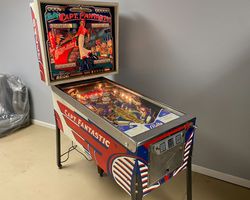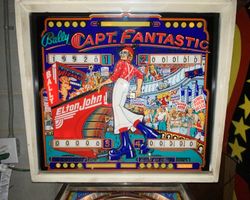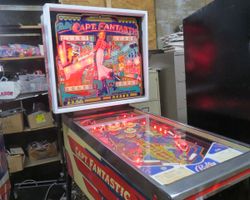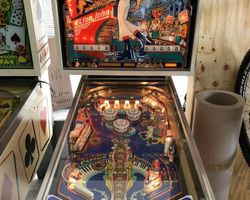Capt. Fantastic and The Brown Dirt Cowboy
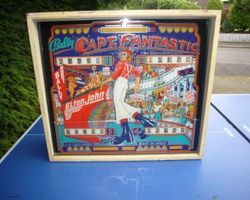
Average Prices: USD $300 to $1,900
Produced: June, 1976
Production Run: 16,155 units
Machine Type: Electro-mechanical
Players: 4
Design by: Greg Kmiec
Art by: Dave Christensen
Capt. Fantastic and The Brown Dirt Cowboy, released by Bally Manufacturing Corporation in June 1976, stands as a distinctive creation from the electro-mechanical (EM) era of pinball. This machine drew its inspiration from the cinematic adaptation of The Who's rock opera Tommy and the celebrated 1975 autobiographical album of the same name by Elton John. The game's title, "Capt. Fantastic and The Brown Dirt Cowboy," directly references Elton John and his long-time lyricist Bernie Taupin, respectively. The backglass art further emphasizes this connection, prominently featuring Elton John in his character from the Tommy movie, engaged in a pinball game. Even a lyric from the album's title track, "From the end of the world to your town," finds its place at the top center of the backglass.
The design of Capt. Fantastic was the work of Greg Kmiec, with the vibrant and detailed artwork executed by Dave Christensen. The production of this machine was notable for its sheer volume, with 16,155 units manufactured, marking it as a significant commercial success for Bally at the time. Its popularity prompted Bally's Vice President of Marketing, Tom Nieman, to arrange for a game to be shipped to Elton John in Toronto while the artist was recording, resulting in the memorable flyer depicting the artist in a Canadian hockey jersey. Elton John later requested additional machines for his residences and for his mother in the UK, highlighting the machine's widespread appeal.
Intriguing production details surround the artwork, particularly the backglass. Dave Christensen incorporated subtle depictions that initially went unnoticed by Bally management, leading to what collectors refer to as the "X-rated" or "uncensored" backglass. A small number of these made it into circulation before Bally mandated changes, which involved adding mirrored stars over the objectionable elements. However, these stars did not always fully obscure the art, a deliberate choice by Nieman and Christensen to minimize alterations to what they recognized as a highly anticipated game. The backglass also holds personal touches, with Nieman himself depicted in a three-piece suit and Paul Faris represented as 'Brutus'. An "Easter egg" score of 31775 on the backglass commemorates the March 17, 1975, New York premiere party for Tommy.
Beyond the backglass, minor production variations exist, such as a small quantity of playfields produced with orange star rollover inserts instead of the standard green, and some featuring a white drop target Special insert instead of the usual red. These variations are rarely seen, suggesting they were likely the result of material shortages during the extensive production run. Another subtle detail that briefly appeared on early playfields was the silkscreened signatures of designer Greg Kmiec and artist Dave Christensen at the bottom of the playfield. Bally management quickly ordered their removal, with only a very limited number of these "signed" playfields reaching production.
Signature Features and Design
Capt. Fantastic is defined by its striking visual presentation and a unique mechanical layout. The backglass artwork is a central element, capturing the flamboyant aesthetic of the 1970s and Elton John's persona. Its vibrant colors and intricate details, including the "hidden gems" Christensen incorporated, establish an immediate connection to the licensed theme. The cabinet art complements this, making the machine instantly recognizable in any arcade or collection.
Mechanically, the machine stands out due to its distinctive flipper arrangement. It features four flippers: the two standard flippers at the bottom of the playfield, an additional upper flipper on the right side, and a unique double flipper setup on the left side, where two flippers are positioned in series. This configuration immediately changes the dynamics of ball control and shot opportunities compared to many contemporary designs.
A prominent playfield feature is the 5-bank drop target assembly positioned on the left side. These targets are not merely points objectives but are integral to advancing game progression. The right outlane incorporates a detour gate, a mechanism that can save a draining ball, adding a layer of defense and extending play. For scoring, the machine includes the "Over The Top buzzer," a distinctive auditory cue that activates upon reaching 100,000 points, a mechanical satisfaction unique to the EM era. These elements combine to create a visually captivating and mechanically engaging pinball experience that reflects the innovation of its time.
Playfield and Mechanics
The playfield of Capt. Fantastic presents a layout designed to encourage strategic target clearing and bonus accumulation, characteristic of its electro-mechanical nature. At the core of the lower playfield are the two main flippers, providing fundamental control. On the left side, above the main flipper, is the distinctive double flipper arrangement, allowing for complex multi-flipper plays towards the upper playfield. An additional upper flipper on the right side facilitates shots across the playfield and into the top lane area.
The primary objective on the left side of the playfield is the 5-bank drop target assembly. Directly above these targets, a left orbit shot winds its way towards the upper playfield, punctuated by rollover switches. On the right side, a corresponding right orbit also features rollover switches. The upper playfield is dominated by three pop bumpers arranged in an upside-down triangle formation, creating a lively area for scoring and ball movement. Two standup targets are strategically placed: one above and to the left of the top left bumper, and another above and to the right of the top right bumper, offering additional scoring opportunities.
Above the pop bumpers, three ball lanes contribute to bonus scoring. The left and right lanes are crucial for doubling the end-of-ball bonus, a key strategy for high scores. The center lane activates the right outlane diverter, a mechanism that can redirect a ball from the right outlane back into the right inlane, offering a temporary save. The right inlane itself lights for an Extra Ball under specific conditions. Artwork on the playfield mirrors the backglass's vibrant 1970s aesthetic, with bright colors and thematic elements that immerse the player in the Elton John-inspired world. While lighting is simpler than modern machines, illuminated inserts clearly indicate lit objectives like Extra Ball or Special, guiding player focus. The tactile feedback of the mechanical score reels, chimes, and buzzing sounds are integral to the game's atmosphere, providing satisfying aural cues for every hit and score.
Gameplay Dynamics
Gameplay in Capt. Fantastic is centered around achieving high scores through bonus accumulation, target completion, and strategic use of the playfield's unique features. As an electro-mechanical machine, the scoring system relies on mechanical reels, with maximum displayed scores often limited to 99,990 or 199,990 points. This allows for "rolling the game," where the score resets to zero after reaching the maximum, adding a layer of challenge for top players to see how many times they can "roll" it. A notable highlight is the "Over The Top buzzer," which loudly activates upon reaching 100,000 points, serving as a significant aural reward.
The ruleset is straightforward, with progression tied to the current ball in play, meaning objectives do not carry over between balls. Bonus points are accumulated by activating star rollovers scattered across the playfield and within the orbit shots. This bonus can be doubled by successfully navigating the ball through both the left and right lanes located at the top of the playfield, making these shots high-priority.
The 5-bank drop targets on the left side are central to the game's objectives. Completing this bank once lights the Extra Ball at the right inlane, offering a chance to extend play. Clearing the 5-bank a second time lights the Special at the left outlane, indicating a high-value award. Completing the 5-bank a third time immediately awards a Special. Strategic play involves repeatedly hitting these targets to earn these valuable rewards.
The middle lane at the top of the playfield plays a critical role in defense. Sending the ball through this lane activates the right outlane diverter, which remains open until it saves a ball, redirecting it to the right inlane. Once used, the diverter closes and must be reactivated by hitting the middle lane again. This mechanism introduces a tactical decision-making element, as players must decide when to risk a shot to the middle lane to protect against outlane drains. The challenge of mastering the unique four-flipper setup, particularly the stacked flippers on the left, requires precision and control to consistently hit the drop targets and navigate the upper playfield.
Reception and Legacy
Capt. Fantastic and The Brown Dirt Cowboy holds a complex yet largely positive standing within the pinball community, a reflection of its era and distinctive design. Its most consistent strength, frequently lauded by enthusiasts, is its artwork. The backglass, in particular, is often described as a vibrant and detailed representation of the 1970s aesthetic, with its specific thematic connection to Elton John appealing to a broad audience. The "hidden gems" and the historical anecdotes surrounding the "X-rated" versions further contribute to its visual allure and collector appeal. Many players connect with the machine through childhood memories, giving it a strong nostalgic resonance.
The gameplay of Capt. Fantastic is often characterized as fast-paced, especially when the machine is well-maintained and properly tuned. This speed, combined with the satisfaction of hitting the drop targets and achieving high bonus scores, contributes to an addictive quality for many players. The machine's unique features, such as the four-flipper setup, the 5-bank drop targets, the right outlane detour gate, and the satisfying "Over The Top buzzer," are frequently cited as engaging elements that define its play experience. As an electro-mechanical game, its classic chimes, buzzers, and the mechanical clack of score reels are appreciated by those who value the tactile and auditory feedback of EM machines.
However, the machine also garners specific criticisms. A common point raised is that the gameplay can become repetitive. Despite the multiple flippers, some players find the shot variety limited, often revolving predominantly around the 5-bank drop targets. The double flipper arrangement on the left, while unique, is sometimes perceived as a gimmick, leading to frustrating drains between the flippers for some players, while others find it a challenging element to master. The reliance on hitting the same targets repeatedly can lead to a sense of shallow depth when compared to the more elaborate rulesets of later solid-state machines. Furthermore, the overall experience is highly dependent on the machine's condition and maintenance; a worn or untuned Capt. Fantastic may not play as intended.
Despite these critiques, Capt. Fantastic's legacy is firmly established. Its impressive production run of over 16,000 units cemented its place in pinball history and ensured its widespread availability. It served as a powerful example of the commercial success achievable with a well-executed licensed theme, demonstrating the appeal of tying a game to popular culture. Its artwork remains highly regarded, influencing collectible value and contributing to its enduring visual impact. The machine stands as a quintessential 1970s EM title, revered by collectors for its historical significance, unique mechanical quirks, and vibrant artistic expression, representing a period of experimentation and mass appeal in pinball design.
Sponsored Links
 Ebay Listings
Ebay Listings
 Auction Results
Auction Results
| Cost | Location | Date |
|---|---|---|
| USD $1,300 |  Georgia, United States Georgia, United States |
25 October, 2025 |
| USD $1,799 |  Virginia, United States Virginia, United States |
31 May, 2024 |
| USD $3,000 |  United States United States |
13 March, 2024 |
| USD $3,000 |  United States United States |
11 March, 2024 |
| USD $4,500 |  Minnesota, United States Minnesota, United States |
01 December, 2023 |
| USD $4,500 |  Indiana, United States Indiana, United States |
09 August, 2023 |
| USD $3,500 |  Virginia, United States Virginia, United States |
07 February, 2023 |
| USD $4,450 |  California, United States California, United States |
02 February, 2023 |
| USD $2,995 |  Illinois, United States Illinois, United States |
11 December, 2022 |
| USD $3,600 |  Indiana, United States Indiana, United States |
10 July, 2022 |


Private Policy · Search Website · Contact Us
As an eBay Partner, we may earn a commission from qualifying purchases made through links on this site, at no additional cost to you.
All trademarks and copyrighted materials remain property of their respective owners. All other content copyright 2007 - 2026 Pinpedia.

